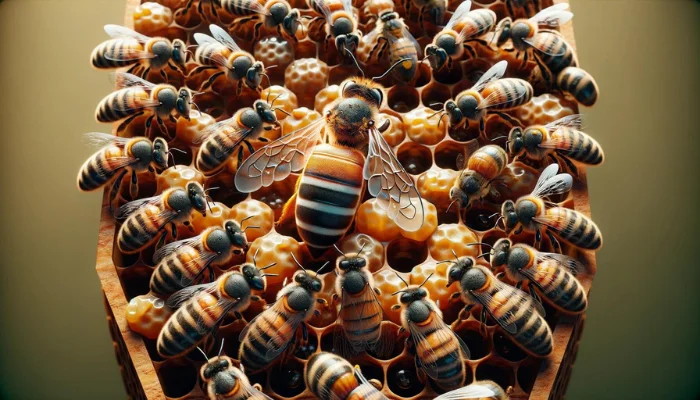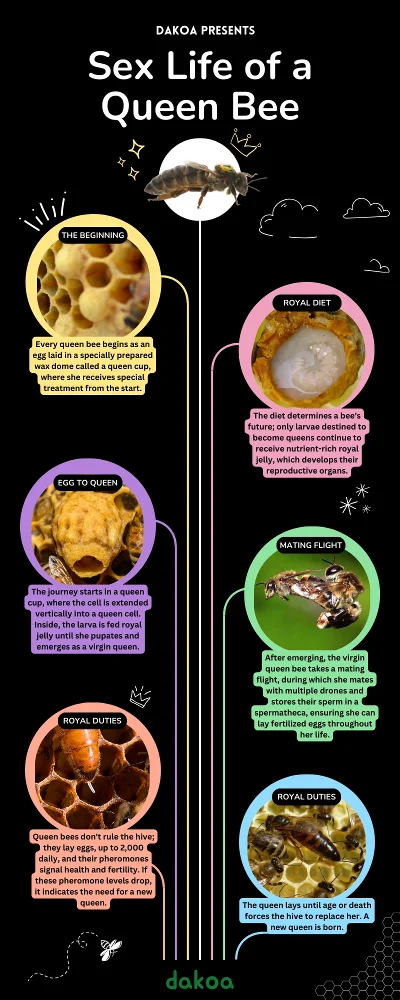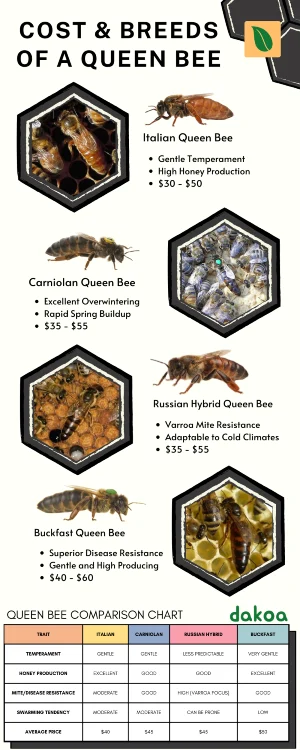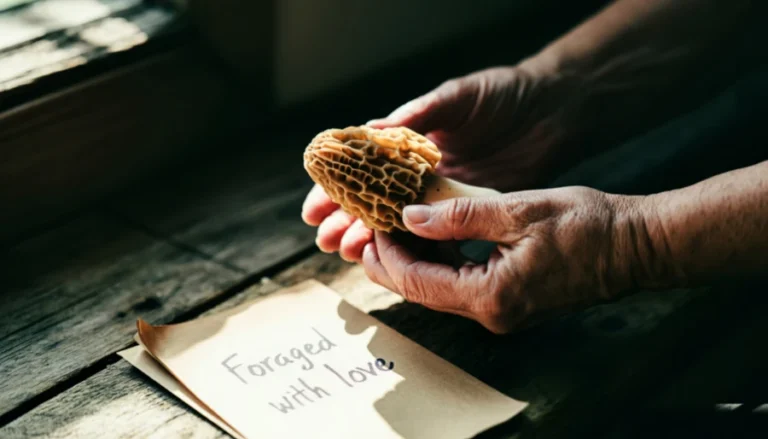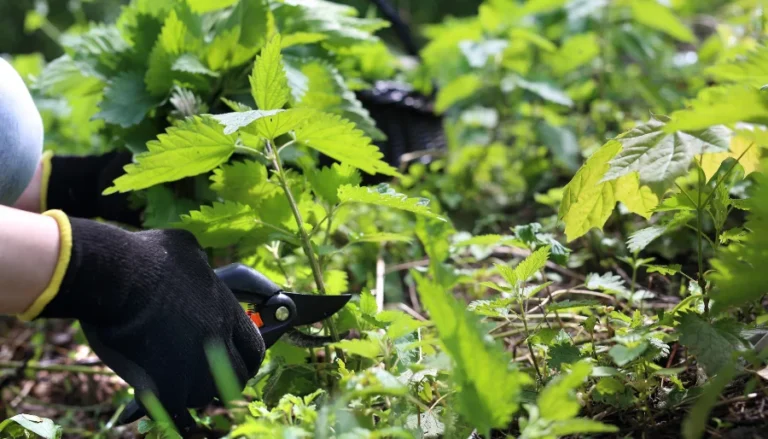Have you seen The Bee Movie? The family comedy from 2007?
It’s a cute movie. It’s also completely inaccurate. Bee hives aren’t ruled over by a queen. The queen serves the hive, simple as that. But they are extremely valuable to that hive. Without a queen, the hive can’t grow and will eventually fade away.
Queen bees aren’t just born; they’re meticulously created by the hive as needed, and they’re the most important bee.
The Steps To Become Queen Bee
The Royal Beginning
Every queen bee starts from the same humble beginning as any other bee—an egg laid in a queen cup. These queen cups are wax dome-shaped cups prepared specifically for future queens. The eggs in these cups are treated differently right from the start and will be expanded as the larvae queen grows.
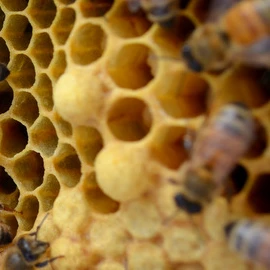
The Role of Royal Jelly
The key to becoming a queen lies in the diet. All young larvae are initially fed royal jelly, a nutrient-dense secretion from nurse bees. However, only those destined to become queen honey bees continue to receive this exclusive diet throughout their development. This special diet of royal jelly triggers the development of the queen’s reproductive organs, setting her apart from worker bees.
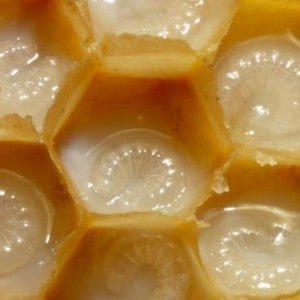
From Egg to Queen
The journey begins in a specially constructed cell called a queen cup. When an egg is laid in a queen cup, nurse bees extend the cell vertically, creating what is known as a queen cell. Inside this chamber, the larva (future queen) is nurtured with royal jelly until she pupates and finally emerges as a virgin queen.
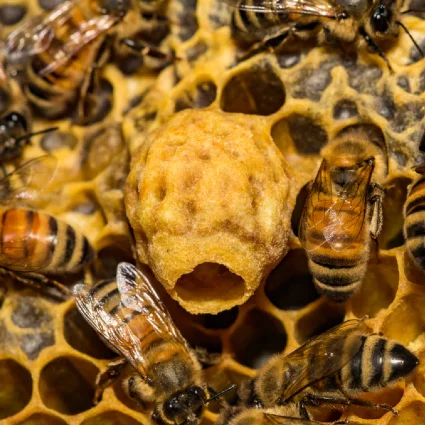
Mating Flight and Reproduction
Upon emerging, the virgin queen bee takes her mating flight. During this flight, she mates with multiple drone bees in areas known as mating nucs. This mating flight is crucial, as it provides her with the genetic material she will need to lay fertilized eggs for the rest of her life. The queen stores the sperm in a special organ called the spermatheca.

The Queen’s Role in the Hive
Contrary to popular belief, queen bees don’t rule the hive like monarchs. They’re essential for reproduction, but the hive operates democratically. The queen’s primary role is to lay eggs—up to 2,000 per day. Her pheromone levels signal to the worker bees that she’s healthy and fertile, maintaining harmony and unity within the hive. If the pheromone levels drop, it could indicate that the queen is aging or unhealthy, prompting the workers to rear a new queen.
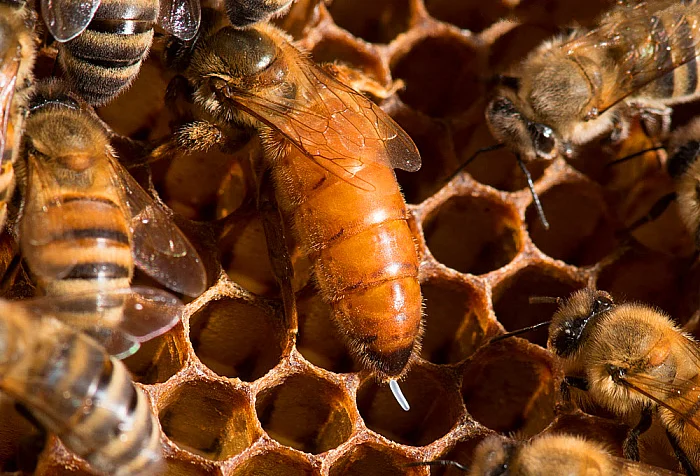
Why and How Hives Make New Queens
Hives create new queens for several reasons:
- Queen Death: If the current queen dies, the hive becomes queenless and must quickly rear a new honey bee queen to ensure colony survival.
- Supersedure: When a queen becomes unfit, the workers (female bees) replace her by raising a new queen in a supersedure cell. And yes, the workers will even kill their aging queen to replace her with a new, virile one, if needed.
- Swarming: When the hive becomes overcrowded, the bees prepare to swarm. The old queen leaves with a portion of the bees, and the remaining colony rears a new queen in swarm cells.
The 3 Types of Queen Cells
Supersedure Cells
Used to replace an unfit queen, these cells are often located on the face of the honeycomb. When a queen becomes old, injured, or otherwise unable to perform her duties effectively, the worker bees will rear a new queen in these cells. The existing queen remains in the hive until the new queen emerges.
Once the new queen is ready, she often kills the old queen to take over the colony. If the old queen isn’t killed by the new queen, the worker bees may eventually expel or kill her to ensure the new queen takes her place. This ensures the hive always has a single, healthy queen to lead it.
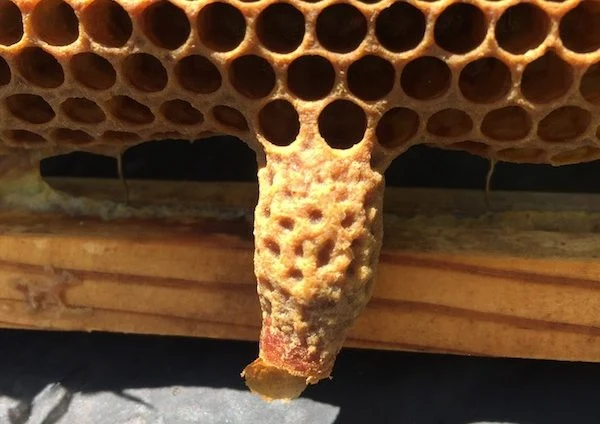
Swarm Cells
Created for new queens when the colony prepares to swarm, these cells are found along the comb margins. Swarming is the natural process by which a colony splits to form a new colony, usually due to overcrowding or the need for expansion.
The original queen leaves with a portion of the bees to find a new home, while the swarm cells nurture new queens who will emerge and lead the remaining hive. These cells ensure that both the departing and remaining groups have a viable queen.
Emergency Cells
Built in response to the sudden loss of a queen, normal brood cells are converted to emergency queen cells. When a hive becomes unexpectedly queenless, worker bees must act quickly to rear a new queen. They select young larvae from standard brood cells and force-feed them royal jelly, transforming these cells into emergency queen cells. This rapid adaptation guarantees the colony’s survival by creating a new queen to restore order and functionality to the hive.
Key Differences: Queens vs. Workers
In the world of honeybees, the distinctions between a queen bee and worker bees are profound, rooted in their roles and life cycles.
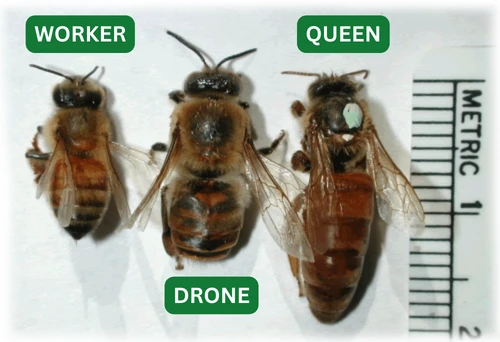
Role and Responsibilities
Queen Bee’s Job:
- Egg Laying: The primary role of the queen bee is to lay eggs. A healthy queen can lay up to 2,000 eggs per day during peak seasons.
- Pheromone Production: She emits special pheromones that help maintain hive cohesion and suppress the reproductive abilities of the worker bees. This is vital for the hive’s unity and function.
- Life Span: A queen bee’s life span typically ranges from 2 to 3 years, but she can live up to five years in optimal conditions. Her longevity is due to her exclusive diet of royal jelly, rich in proteins and fatty acids.
Worker Bees’ Job:
- Foraging: Female worker bees are responsible for gathering nectar, pollen, and water, essential for the hive’s survival.
- Hive Maintenance: Worker bees perform various tasks such as cleaning the hive, building combs, and feeding larvae. They also manage the temperature and humidity within the bee hive.
- Nursing: Young worker bees, known as nurse bees, feed and care for the brood. They produce bee bread, a mix of pollen and nectar, to nourish the larvae.
- Defense: Worker bees protect the hive from intruders. They have barbed stingers, which can only be used once.
Developmental Stages and Diet
The only difference between queens and worker bees lies in their diet during the larval stage. All larvae are initially fed royal jelly. After a few days, worker larvae are switched to a diet of bee bread, while queen larvae continue to receive royal jelly throughout their development.
Developmental Stages:
- Queen Bees: Develop in about 16 days, fed exclusively on royal jelly, which promotes the growth of their reproductive organs.
- Worker Bees: Take about 21 days to mature. They transition from royal jelly to bee bread, which supports their non-reproductive development.

Physical Differences
- Size and Shape: Queen bees are larger, with a more elongated abdomen to accommodate their reproductive organs. Worker bees are smaller and more robust, adapted for foraging and other tasks.
- Stingers: The queen bee has a smooth, reusable stinger used primarily to eliminate rival queens. Worker bees have barbed stingers that can only be used once.
- Lifespan: The queen’s exclusive diet of royal jelly and her relatively stress-free role (compared to foraging worker bees) allows her a longer life span. Worker bees live only a few weeks during the busy foraging season.
Reproductive Roles
- Queens: The queen is the only fertile female in the hive, laying both fertilized eggs (which become female worker bees) and unfertilized eggs (which become male drones).
- Workers: While worker bees can lay unfertilized eggs that develop into drones, they don’t lay fertilized eggs. Their role is entirely non-reproductive, supporting the queen and the colony.
What about drones?
Male bees are all called drones. Their only purpose is to mate with a virgin queen during her mating flight, ensuring genetic diversity and the continuation of the hive. Drones develop from unfertilized eggs, have larger eyes for spotting queens, and lack stingers. They live only a few weeks during the mating season and are often expelled from the hive before winter. Despite their short lifespan and singular function, drones are essential for the colony’s genetic health and long-term survival.
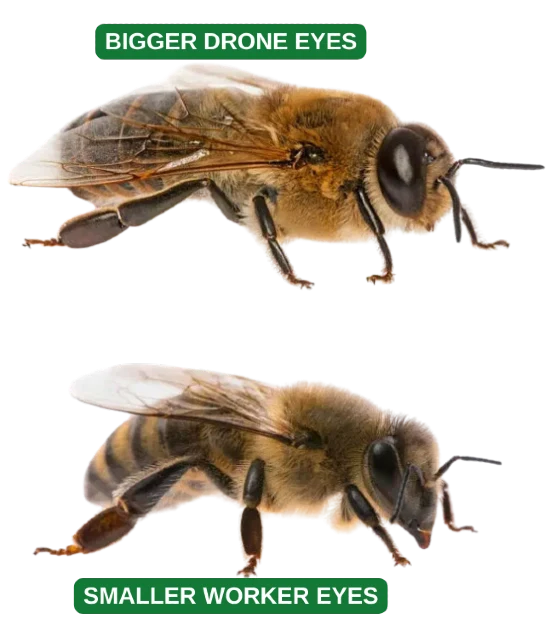
FAQ: All Things Queen Bees
Q: How long does a queen bee live?
A queen bee typically lives 2-3 years but can live up to five years under ideal conditions, thanks to her diet of royal jelly and the hive’s care.
Q: Can a queen bee sting?
Yes, queen bees can sting. Unlike worker bees, their stingers are smooth, allowing them to sting multiple times. This stinger is primarily used to eliminate rival queens. Only drones (male bees) can’t sting you.
Q: How can you identify a queen bee?
Queen bees are larger with a longer abdomen. They are often surrounded by worker bees. Beekeepers may mark them with a spot of paint for easy identification.
Q: What happens if a hive becomes queenless?
In a queenless hive, worker bees will rear a new queen by feeding selected larvae royal jelly and constructing new queen cells. The lack of queen pheromones triggers this emergency response.
Q: Do queen bees control the hive?
No, queen bees don’t govern the hive. The hive operates democratically. The queen’s role is to lay eggs and produce pheromones to maintain hive cohesion.
Q: What is the life cycle of a queen bee?
The queen bee’s life cycle begins as an egg laid in a queen cup. Fed an exclusive diet of royal jelly, she develops into a queen in about 16 days. After mating, she spends the rest of her life laying eggs and maintaining hive unity.
Q: What are the types of queen cells?
There are several types of queen cells (see above for more details):
- Supersedure Cells: For replacing an old or failing queen.
- Swarm Cells: For creating new queens when the hive prepares to swarm.
- Emergency Cells: Built quickly when the hive suddenly becomes queenless.
Q: What’s the importance of pheromones in a hive?
Queen pheromones are crucial for maintaining hive order. They prevent worker bees from laying eggs and ensure the colony functions smoothly.
Q: How much do queen bees cost?
Depends on the breed because, yes, there are different breeds just like dogs. For a full cost by bee breed breakdown, check out our article here.
Q: How do bees decide when to make a new queen?
Bees create new queens for several reasons: if the current queen dies (queenless hive), if the queen is unfit (supersedure), or if the hive is preparing to swarm and spread to a new home. Worker bees initiate the process by building special cells and feeding larvae royal jelly.
Q: What tools are used in queen rearing?
Beekeepers use grafting tools to transfer larvae into queen cups. Queen cages are used to protect developing queens during the critical stages of rearing.
Q: How does the queen bee’s diet affect her development?
The queen bee’s exclusive diet of royal jelly allows her reproductive organs to develop fully, distinguishing her from worker bees, who switch to a diet of bee bread.
Q: What is a mating nuc?
A mating nuc is a small hive where virgin queens mate with drones. This controlled environment ensures the queen receives enough genetic material to lay fertile eggs.
Q: How do bees ensure the quality of a new queen?
Worker bees construct several queen cells to ensure at least one high-quality queen emerges. The first queen to emerge will often eliminate her rivals to become the hive’s new queen.
Insights for New Beekeepers: Frames & Tools
New beekeepers often wonder about the importance of brood frames and how they fit into the queen-rearing process. A brood frame is where the queen lays her eggs, and worker bees care for the developing larvae. These frames are crucial for the growth of a new colony.
Beekeepers also use special tools like grafting tools to transfer larvae into queen cups during queen rearing. This meticulous process ensures that the best larvae are chosen to become future queens.
Understanding the lifecycle and the various roles within a honey bee colony is essential for anyone involved in beekeeping. From the first larvae fed with royal jelly to the emergence of a new queen bee, every step is vital for the colony’s survival.
Tips for Beekeepers
- Monitor Pheromone Levels: Keep an eye on your hive’s pheromone levels. Low pheromone levels can indicate an aging or unhealthy queen.
- Use Quality Queens: Ensure you are rearing or purchasing quality queens to maintain a strong hive.
- Understand the Types of Bees: Recognize the different types of bees in your hive and their roles. This knowledge is crucial for effective hive management.
- Invest in Good Equipment: Using proper equipment like nicot systems and queen cages can make the queen rearing process more efficient.
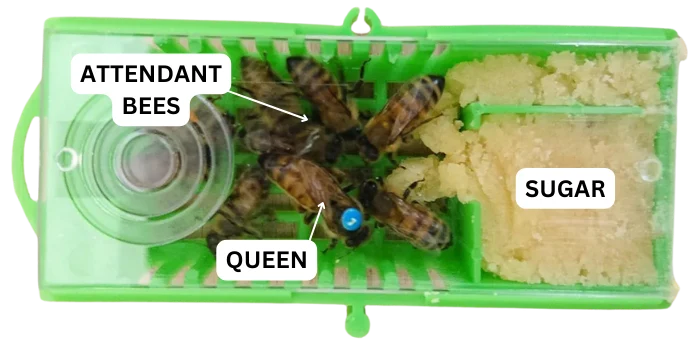
Final Thoughts
More To Discover
- Rethinking Beekeeping: Study Reveals Honeybees’ Struggle in Human-Made Hives
- Solar Farms Are Killing Pollinators And Burning Bees Alive
- European Bumblebees on the Brink: Climate and Habitat Woes, and Our Race to Save Vital Pollinators And 7 Solutions Being Tried Right Now
- How to Keep Bees Away from Your Home and Pool: Top Ways
Queen bees have a vital role in any thriving hive. Their creation is a blend of nature’s precision and the colony’s needs. By understanding and respecting this process, beekeepers can contribute to the health and productivity of their honey bee colonies, ensuring these essential pollinators continue to flourish.
Understanding how queen bees are made reveals the intricate and democratic nature of honey bee colonies. The transformation from egg to queen is a testament to the wonders of nature and the resilience of these social insects. By mastering the process of queen production, beekeepers can ensure the health and longevity of their hives, supporting these vital pollinators.







